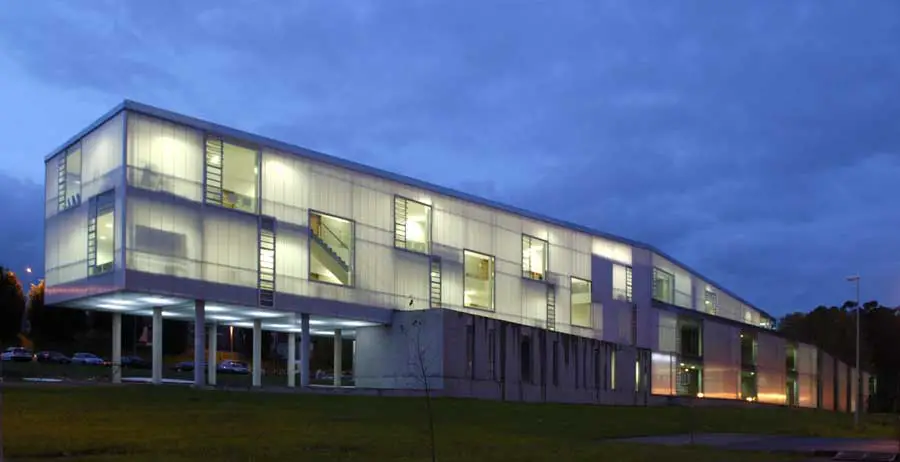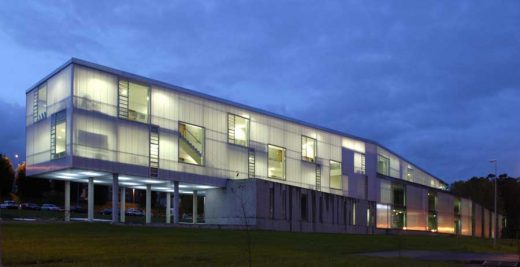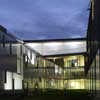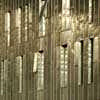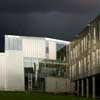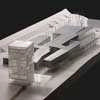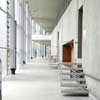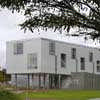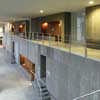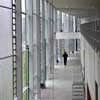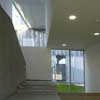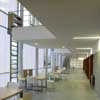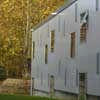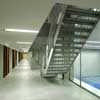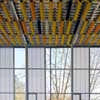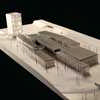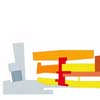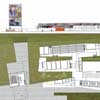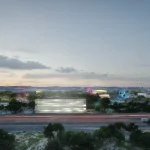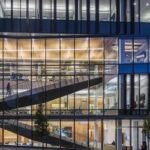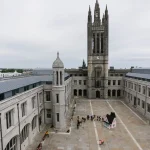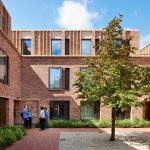Pontevedra Campus, Northwest Spain Building Project, Photo, Design Images
Pontevedra Campus Architecture
Pontevedra Development, Spain design by irisarri-piñera architects
7 Sep 2009
University of Pontevedra Campus
Pontevedra Campus, Spain
Design: irisarri-piñera
Facultad Ciencias Educación y Deporte, Centro de apoyo a la transferencia de investigación CATRI y ordenación del Campus de Pontevedra.
In the planning of the Campus of Pontevedra and the buildings of the faculty of education sciences and the CATRI (centro de apoyo a la transferencia de resultados de investigación, Transference of investigation results support center), those geometries shaping “local traces” and a nature still with potential, superput on the intention of creating an atmosphere that results from the permeability and presence of the environmental peculiarities, added to the decision to make the diverse activities of the university life take part among them, through two mechanisms: visual continuities in horizontal and vertical section, and conversion of circulation spaces in relation areas. Thus we obtain multiple scales and environmental sensations.
It leads to taking the most of re-live the river as organizer of the city, to deal and to propose the campus as community space of culture and leisure, and to recover the area of the campus and the river as park and as defined ecozone.
The central area of the campus is pedestrianized and creates a central covered main square covered as a place that holds different events, which “sews” the buildings today isolated. The landscape treatment joins the values of the natural space with the cultural place, coming together an ecozone of bank with a constructed garden, and the campus joins across entail with the river in the net bank path network that connect with the city.
Working with the woodland density so that without losing the physical consistency of the bank, makes this one visible and accessible in the campus central zone, while there is kept the density of ferns and woodland that makes it leafy and withdrawal in others.
A landscape of diverse prunings of the central meadow, is promoted by season plants in a dialogue between everlasting and seasonally areas of the campus.
CATRI’s building is raised as reference that “anchors” visually the campus to the city that belongs to, as presence of a fundamental and public institution. Placed in the center of the new “square”, it passes to form a part of the elements of reference of the landscape, showing above the new woodland of the campus.
The program, with autonomous and differentiated parts, is organized so that every module occupies one floor or one duplex. Its links are the communications nucleus and being involved in a double skin that unifies and allows them to optimize its energetic functioning. The exterior skin of the CATRI doubles, shaping a covered square that is constituted as Pontevedra climate in the campus heart.
We imagine the construction with an appearance sensitive to the environmental changes with which it intergesticulates, light and ethereal but at the same time with a spatial definite presence. The interior modules face with panels of colors finish, taking an exterior translucent or transparent cap according to the case.
The place where it is located, the desirable and nearby presence of the river, and the diverse ones and so different uses, make natural a building of Sciences of the Education, which seeks with decision connecting and opening out for the wealth of the place. The building tries to exploit the enormous wealth of scales and activities of its program turning the spaces of transition and circulation into mechanisms that make share the diverse activities and give them more presence. It is formed in bands of different heights by galleries of stay and distribution orientated to the south and to the campus central area, separating the program in well-defined blocks according to uses and spatial needs.
Spanish text:
Campus de Pontevedra
En la ordenación del Campus de Pontevedra y los edificios de la facultad de ciencias de la educación y el CACTI, se superponen aquellas geometrías que conforman“ las trazas del lugar” y una naturaleza todavía con potencial, a la intención de crear una atmósfera resultado de la permeabilidad y presencia de las peculiaridades ambientales sumado a la decisión de hacer participar entre si a las diversas actividades de la vida universitaria a través de dos mecanismos, continuidades visuales en planta y sección, y conversión de espacios de circulación en áreas de relación, tanto para los usuarios como para el entorno en el que se inserta. De modo que conseguimos múltiples escalas y sensaciones ambientales.
Ello lleva a aprovechar la oportunidad para revivir el río como vertebrador de la ciudad, entender y proponer un espacio comunitario de cultura y ocio, recuperar el área del campus y el río como parque y como ecozona definida.
El lugar dónde se ubica, la deseable y cercana presencia del río, y los diversos y tan distintos usos, hacen natural un edificio de Ciencias de la Educación, que busque con decisión enlazarse y abrirse a la riqueza del sitio. El edificio pretende explotar la enorme riqueza de escalas y actividades de su programa convirtiendo los espacios de transición y circulación en mecanismos que hagan compartir y presentes las diversas actividades. Se configura en bandas de differentes alturas con galerías de estancia y reparto orientadas al sur y al área central del campus, separando el programa en bloques claros por usos y necesidades espaciales.
El proyecto apuesta por utilizar los principios de la arquitectura bioclimática, como perfecta respuesta a los condicionantes del lugar, y la oportunidad de que a través de la construcción se incentive la regeneración del medio circundante. Se trata de establecer una relación entre medio y artificio que redunde en beneficio para ambos, y que a través de la presencia y de la participación de lo edificado con su medio se consiga mantener y mejorar el entorno natural. Todo ello por supuesto de modo que surja a través de la arquitectura, no como prótesis sino como parte esencial de la constitución de la misma.
Construir en fases
Una espina que trepa por la ladera, recoge todos los espacios de circulación y relación que en ella confluyen, permitiendo que el paisaje penetre y atraviese el edificio a la vez que los “brazos enganchados” se extienden por el terreno. De este modo el edificio puede crecer con coherencia y ser “completo” en cada fase. Los diversos brazos al insertarse transforman en lugares intermedios los patios que crean en los que esperamos en un futuro crear diversas atmósferas vegetales.
Ocupar las fases – urbanización provisional
Finalizada la primera fase, estamos construyendo la pista y el pabellón a medida que nos acercamos al río. Con la ocupación anticipada de esta fase se ha ejecutado una urbanización provisional (ya que la ordenación del Campus depende de lentas gestiones administrativas que todavía no la hacen posible) Se necesitaba resolver los accesos, un aparcamiento y el cierre y señalización de las siguientes fases. Se trataba de plantear una actuación no permanente, y por tanto lo menos agresiva y costosa posible. Planteamos pavimento que, a modo de manto, se adaptara a la topografía existente. Se han utilizado pavimentos de ladrillo semimacizo (recuperado de piezas con defecto) contenido en paños modulados por viguetas prefabricadas. Todo ello apoyado sobre el terrreno. Los encuentros con la urbanización preexistente se resuelven con grava de dos colores (blanco y negro) y césped (de rápido crecimiento por estas tierras). Los cierres de obra y vallas con redondos de armado y protecciones propias de obra.
ip6
Se ha desarrollado también un prototipo de banco (ip6, producido por LARUS) que puede ser usado tanto en exterior como en interior y que permite y propicia puntos de intercambio, juego y reunión.
Pontevedra Campus – Building Information
VFacultad Ciencias Educación y Deporte, Centro de apoyo a la
transferencia de investigación CATRI y ordenación del Campus de
Pontevedra.
(University of Pontevedra Campus)
Competition: 2002, 1st Prize
Propriety: University of Vigo
Location: Campus da Xunqueira, Pontevedra
Design team
Architects: Jesús Irisarri Castro, Guadalupe Piñera
Engineering Structure: Antonio Reboreda Mártinez, Ibinco SL
Installations: Ana Maria Vigo, Manuel Lopega, Ibinco SL
Building Stage
Stage 1 2004-06
Building Masters: Jesús Irisarri Castro, Guadalupe Piñera Manso
Technical Architects: Sancho Paramo Cerqueira, Sandra Valverde
Building Company: O.H.L.
Stage 3 – 4 2006-07
Building Masters: as above
Technical Architect: Sancho Paramo Cerqueira
Building Company: O.H.L.
Stage 2 2008
Building Masters: as above
Technical Architect: as above
Building Company: O.H.L.
Photographs: Manuel González Vicente
Distinctions of realized work
Premio SICE 2008 –Consejo Superior de los Colégios de Arquitectos de Espana. 2008
On Site – Architecture in Spain. The Museum of Modern Art, Nueva York 2006
Publications
Arquitectura Plus nº 9
AV monografías nº 129-130 (2008)
Arquitectura COAM 347, 2007
Pasajes 85
Catálogo On site – Architecture in Spain. The Museum of Modern Art, New York 2006
Arquitectura Plus • Visión y obra de 44 arquitectos españoles 2006
Future • nº 02 (2006) • Abril 2006
Arquitectura Viva • nº 104 (2005) • La lista del MOMA – Nueva York expone la
arquitectura Española • 2005
As persoas do verbo. Serie documental A idea Construida. Consello da cultura Galega 2005
Escalas. III Encontros Internacionais de Arquitectura. Ed. Andar Quatro S.L. 2005
Monografías de Arquitectos galegos. Consello da cultura Galega 2004
Enciclopedia de Artistas Gallegos. Ed. Nova Galicia Edición SL 2004
“Obradoiro”, nº 30, 2003
Exhibitions
Arquitectura para una contingencia.– Centro Galego de Arte Contemporánea Santiago, 2007
On site – Architecture in Spain. The Museum of Modern Art, New York 2006
Galicia XXI architecture. Embassy of Spain, Washington DC 2004
Pontevedra Campus images / information from irisarri-piñera
Location: Pontevedra, Spain
Architecture in Spain
Spanish Architecture Designs – chronological list
Architecture Walking Tours by e-architect
Spanish Architecture – Selection
Estadio Pasaron, Pontevedra
Design: ACXT / Idom
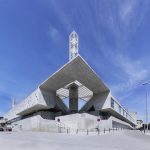
photograph : Héctor Santos-Díez
Pontevedra Stadium Building
Redondela house, Pontevedra
irisarri-piñera
Pontevedra house
Ponte Caldelas, Pontevedra
A-cero
Pontevedra Hotel Building
ATARIA – Centro de Interpretación de la Naturaleza de Salburúa
QVE arquitectos
ATARIA
Comments / photos for the University of Pontevedra Campus Spain Architecture page welcome

